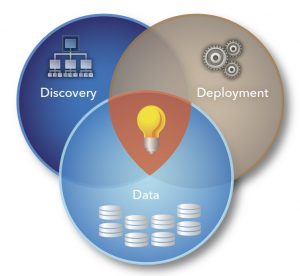I've been playing around with this equation to show how big data derives value using analytics. From my perspective, it looks like this: Big data + analytics = Hadoop + SAS = Value.
To expand the equation, I started thinking about the V's of big data and the D's of analytics.
 You've probably heard about the three V's of big data – volume, variety, and velocity – for years. More recently, the V's have expanded to include others like veracity and value. All of these V's simply describe the attributes of big data, which is fine for understanding what makes up big data.
You've probably heard about the three V's of big data – volume, variety, and velocity – for years. More recently, the V's have expanded to include others like veracity and value. All of these V's simply describe the attributes of big data, which is fine for understanding what makes up big data.
But, what are the D's of analytics? This requires you to go beyond just defining big data and making sense of it. For this, you need the three D's of analytics: data, discovery and deployment.
You may have seen the three D's earlier this week in a post by Daniel Teachey. But lets look at each one in more detail.
Data is about where best to store, manage and secure the data while also making it available for use. The answer is often Hadoop, a low-cost platform designed for storing and processing the volume and the variety seen with big data.
Now that you have a platform for storing our big data, it's time to tackle the next issue: How do you monetize this asset for the business in a timely fashion?
Discovery is the key to getting value out of big data. Discovery means that you can apply analytics to your data to create new insights and drive innovation.
Being able to load data into Hadoop allows you to go from data to discovery easier and faster. Discovery is also made easier and faster through visualization. Another very important D in making the discovery process work is "domain," as in domain or industry knowledge.
Discovery is important, but it is only one of these three important components. After all, if you don't make use of the new information you discovered, it won't matter to the business. And that brings us to the third and most important D.
Deployment. Deployment means taking action. This action is based on the insight you derived using discovery on your data, so you can make better, more informed decisions. (By the way, two additional D's just popped up: decisions and derive.)
Deployment can mean deploying analytic-based code to run in existing systems. This will help you improve existing business processes or create new, better processes. Deployment also allows you to integrate analytic insight into reports that help drive better decisions. Deployment is probably the most important part, because its the process that enables you to take the actions to capture the value out of your big data.
Deployment is the implemention of analytics to provide you with results. SAS Visual Analytics, SAS Visual Statistics and SAS Scoring Accelerator offerings as well as other of our next-generation in-memory technologies offer the fastest ways to deploy and make use of analytics throughout your organization.
To learn more, register for one of the global road shows Powered by SAS + Hadoop.
